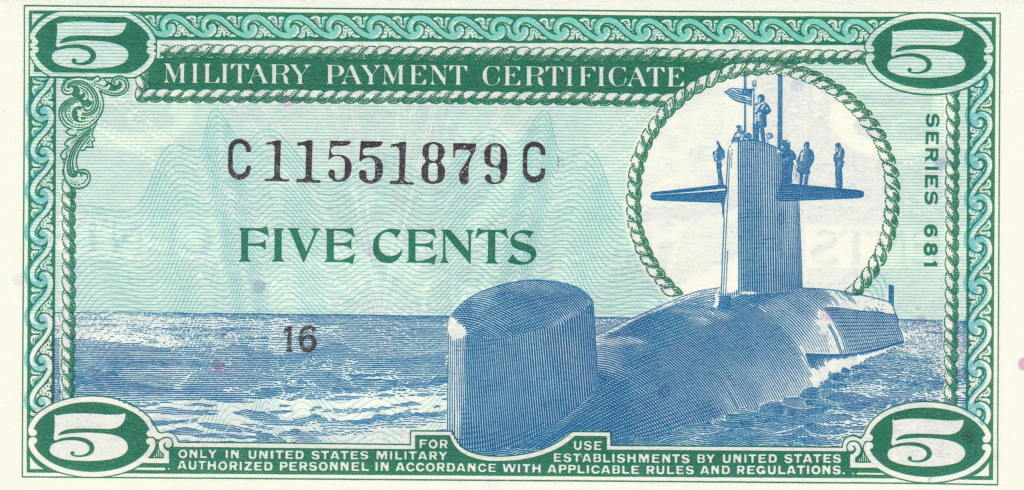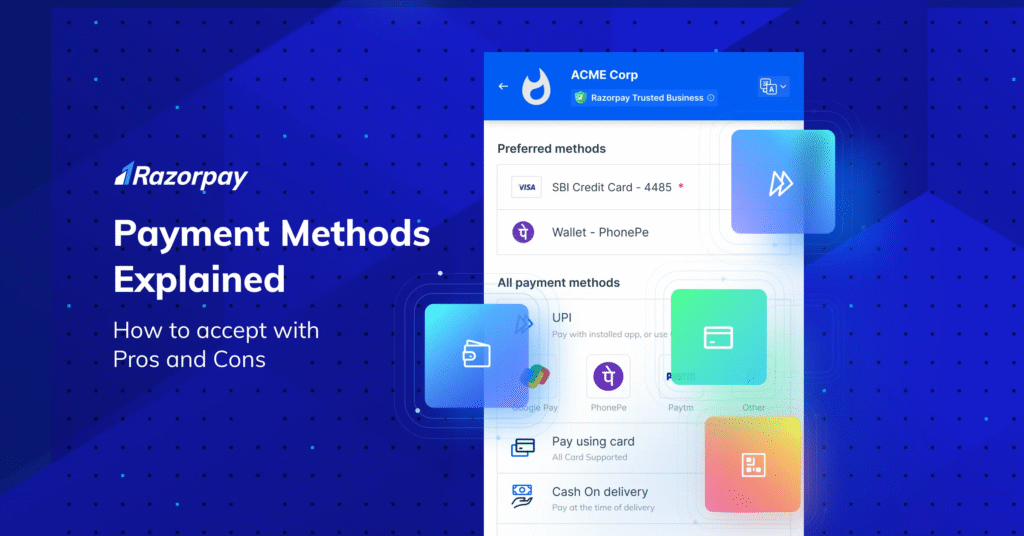
The 5 Cent Military Payment Certificate (MPC) was a specialized form of currency issued to U.S. military personnel stationed overseas from 1946 to 1973. It was designed to facilitate secure and controlled financial transactions, minimizing the risk of black-market activity and currency manipulation during deployments. The 5 Cent MPC served as a vital tool in managing military finances by providing a controlled medium of exchange for small transactions in various post-war and Cold War settings.
These certificates came in various series with distinct designs and were part of a broader system that included denominations up to twenty dollars. The 5 Cent notes often saw use in daily purchases such as those at military exchanges and other approved establishments, emphasizing their practical importance beyond just being collectible artifacts today.
Collectors and historians value the 5 Cent Military Payment Certificate not only for its monetary worth but also for its role in military history and finance. The certificates reflect the efforts made to stabilize military economies abroad and maintain operational security through periodic surprise swaps of currency series.
History and Purpose of the 5 Cent Military Payment Certificate
The 5 Cent Military Payment Certificate (MPC) played a specific role in the financial system supporting U.S. military personnel overseas. It acted as a controlled currency designed to manage military spending and reduce potential economic issues in foreign deployments. The distinct issuance history and various series highlight its evolving function.
Origins and Issuance
The 5 Cent MPC was introduced after World War II as part of a larger series of military payment certificates issued between 1946 and 1973. These certificates replaced regular U.S. currency for military personnel stationed abroad, particularly in occupied or foreign countries.
Issued by the U.S. Department of Defense, MPCs were designed to cover denominations from as low as five cents to as much as twenty dollars. The 5 Cent note was among the smallest denominations, typically used for minor transactions on military bases. Over time, fifteen official series were printed, with some additional series produced but never circulated.
Purpose During Military Deployments
The primary purpose of the 5 Cent MPC was to prevent black market activities and currency manipulation in foreign countries hosting U.S. forces. By using MPCs instead of local or U.S. currency, military authorities controlled spending within specific environments.
This currency simplified logistical challenges of paying troops abroad and helped stabilize local economies by limiting access to U.S. dollars. It also reduced risks of inflation in the host nation caused by excess currency influx. The 5 Cent certificate allowed for smaller financial exchanges while maintaining secure and regulated military finances.
Major Series and Variations
The 5 Cent MPC was printed in multiple series, each with unique design elements and security features meant to prevent counterfeiting. These series are commonly identified by numbers or letters, with some series more common than others.
Among the fifteen official series, notable ones include the early post-war issues and later series used during conflicts such as the Vietnam War. Each iteration of the 5 Cent certificate had variations in color, printing style, and anti-counterfeiting measures. Collectors value rarer series and replacement notes, which sometimes command higher prices in the memorabilia market.
Design Features and Security Measures
The 5 Cent Military Payment Certificate combines specific visual elements with intricate security features to deter counterfeiting and unauthorized use. These features reflect both practical design choices and deliberate anti-fraud measures essential to maintaining the certificate’s integrity.
Obverse and Reverse Imagery
The obverse side of the 5 Cent Military Payment Certificate prominently displays the denomination and the phrase “United States Military Payment Certificate.” Its layout is simple yet authoritative, ensuring quick recognition by military personnel.
On the reverse, detailed patterns and security motifs are common. These intricate backgrounds make duplication difficult. The front often uses strong typography, while the back incorporates complex line work, intended to confuse counterfeiters and protect the certificate from forgery.
Anti-Counterfeiting Techniques
Security was built into these certificates through several methods. The paper stock was of high quality, thicker and more durable than standard currency paper. This made replication more challenging.
Complex engraved patterns occupied large areas to prevent easy copying. Microprinting and fine line engraving reduced risk of fraudulent duplication. Additionally, color variations and specific inks were used to distinguish genuine certificates from fakes.
These methods combined to protect against common counterfeiting tactics faced by military finance authorities overseas.
Signatures and Serial Numbers
Each 5 Cent Military Payment Certificate includes printed signatures, usually of authorized officials, establishing authenticity. These signatures were difficult to replicate and were key security identifiers.
Serial numbers appeared prominently and uniquely on every certificate. They were essential for tracking issuance and preventing reuse. The numbering system functioned similarly to modern banking controls for debit cards, where unique codes help secure accounts by eliminating duplication risks.
Together, signatures and serial numbers were fundamental in verifying each certificate’s legitimacy during circulation.
Collecting 5 Cent Military Payment Certificates

Collectors focus on factors like condition, authenticity, and rarity when acquiring 5 Cent Military Payment Certificates. Each element significantly impacts the note’s value and desirability within the market.
Grading and Condition
The condition of a 5 Cent Military Payment Certificate is crucial to its value. Notes are graded on their physical state, ranging from “Poor” to “Uncirculated.” Uncirculated notes show no signs of wear, creases, or folds, making them highly sought after.
Collectors look for sharp corners, vibrant ink, and intact paper. Damage, such as tears, stains, or heavy folds, reduces a note’s grade and market price. Even slight pen marks or writing can lower its desirability.
Preservation efforts often start with careful handling. Notes stored in protective sleeves or albums maintain better condition over time. Proper storage prevents issues like paper brittleness and color fading.
Authentication and Preservation
Authenticating a 5 Cent Military Payment Certificate ensures it is genuine and not a counterfeit or reproduction. Experts examine printing techniques, serial numbers, and paper quality against known standards.
Certificates from series such as 481 and others include identifiable elements, like specific watermarks or serial number formats. Authentication often requires magnification tools or specialist knowledge in military currency.
Preservation goes beyond storage. Avoid exposure to moisture, sunlight, and fluctuating temperatures, as these accelerate degradation. Professional conservation may be needed for older or rare notes to stabilize their condition without harming original features.
Rarity and Scarcity
Rarity of 5 Cent Military Payment Certificates varies by series and print run. Series like 481 had millions printed, making them common, yet specific serial numbers or replacement notes can be scarce and more valuable.
Scarce notes may include those withdrawn early or never circulated. Notes with low serial numbers, star replacements, or printing errors are particularly prized by collectors.
The historical context also affects rarity. Certificates circulated in fewer countries or during shorter time frames tend to be harder to find. Demand for these scarce variations can significantly raise their market value.
| Factor | Impact on Value |
|---|---|
| High Grade | Increases value |
| Confirmed Authenticity | Essential for sale |
| Series & Scarcity | Drives rarity premium |
Value and Market Trends
The value of 5 Cent Military Payment Certificates varies based on several specific criteria. Market activity shows shifting demand influenced by condition and rarity, while investment interest reflects cautious but steady appreciation. Understanding these factors helps collectors and investors make informed decisions.
Factors Affecting Value
The most significant factors include series, condition, and rarity. For example, Series 481 5 Cent MPC notes, issued between 1951 and 1954, have values ranging from $1 in poor condition to $15 in perfect condition. The note’s grade—such as uncirculated versus heavily worn—plays a major role in price differences.
Scarcity of certain series or printing errors can also increase value. Certificates with crisp printing, intact perforations, and no markings tend to command higher prices. Market prices often fluctuate with collector demand and availability.
Recent Auction Results
Recent auction results indicate steady interest in 5 Cent MPCs. Notes in lower grades regularly sell between $2 and $5. Higher-grade certificates, especially from sought-after series, have fetched $10 to $20 each.
Notably, Series 472 and 481 notes have appeared frequently, suggesting these series remain of high interest. Auction houses report that provenance and historical documentation tied to specific certificates can boost final sale prices.
Investing in M0000ilitary Payment Certificates

Investing in 5 Cent Military Payment Certificates requires careful attention to authenticity and condition. Unlike real estate line of credit products or home equity loan rates in Virginia, which are influenced by broader economic factors, MPCs depend more on collector interest and historical significance.
Investors should consider long-term storage and preservation strategies to maintain value. Certificates kept in acid-free sleeves and away from light hold better market potential. While not a traditional financial asset, MPCs can provide modest returns if chosen with knowledge of market trends and certificate specifics.
Comparisons with Other Military Currencies
The 5 Cent Military Payment Certificate (MPC) served a specific role within the broader system of military currencies. Its design, use, and purpose distinguish it from other forms of military money, especially Allied Military Currency (AMC) and standard U.S. currency. Understanding these differences clarifies its function in military finance and control.
Comparison to Allied Military Currency
Allied Military Currency (AMC) preceded Military Payment Certificates and was issued during World War II for use by Allied forces in occupied territories. AMC was printed to match the monetary units of the local country where it circulated, supplementing local currency and supporting military operations.
In contrast, the 5 Cent MPC was denominated in U.S. dollars but only valid within U.S. military installations overseas. Its purpose was narrower, focusing on preventing currency manipulation, controlling black market activities, and protecting the military economy. Unlike AMC, which adjusted to local currencies, the MPC system maintained a consistent dollar value regardless of local inflation or currency depreciation.
The 5 Cent MPC formed part of a controlled money supply system that rotated series regularly, minimizing the risk of counterfeit and unauthorized use. AMC lacked this rotation feature, making MPCs more secure and tightly regulated.
Distinctions from Standard US Currency
The 5 Cent MPC differs essentially from standard U.S. currency in usage, design, and legal status. Unlike U.S. dollars, MPCs were not legal tender outside military bases. They couldn’t be spent in civilian markets, limiting their circulation strictly to military personnel and facilities abroad.
Design-wise, the 5 Cent MPC incorporated unique security features and changing series to deter counterfeiting—measures not typically required in domestic currency. Its low denomination made it functional for everyday transactions within bases, such as small purchases at mess halls or stores.
Economically, MPCs helped stabilize military pay without exposing service members to local currency fluctuations. This prevented loss of value due to local inflation or black market exploitation, issues that U.S. dollar cash in foreign zones would have faced.
| Feature | 5 Cent MPC | Standard US Currency |
|---|---|---|
| Validity | U.S. military facilities overseas | Nationwide, civilian use |
| Legal Tender Status | Restricted; military only | General legal tender |
| Security Measures | Frequent series changes | Standard anti-counterfeiting |
| Purpose | Control black market and inflation | General commerce and trade |
Legal and Historical Significance
The 5 Cent Military Payment Certificate (MPC) served a specific economic and legal function within the U.S. military during its use. Its design aimed to control currency flow and protect military personnel from inflation and black-market activities. The certificate’s legal status and procedures surrounding its exchange after service reveal its structured role in military finance and postwar policy.
Role in Military Economics
The 5 Cent Military Payment Certificate was part of a broader system that ensured secure and stable currency for U.S. troops overseas. Its primary purpose was to prevent inflation and currency manipulation in foreign economies where U.S. forces operated.
These certificates allowed the military to bypass using local currency, which varied in value and was often subject to illicit trade. The specific denomination of five cents facilitated small transactions, maintaining daily economic activities among service members.
By isolating military currency from local and civilian economies, the MPC helped stabilize the soldiers’ purchasing power. It reduced the risk of counterfeit money, which was a concern in conflict zones. Ultimately, the 5 Cent MPC was a targeted economic tool that communicated stability and control within military operations.
Legal Tender Status and Postwar Exchanges
The 5 Cent Military Payment Certificate was not legal tender outside the military context but functioned as official currency within designated U.S. military zones. This limited legal tender status protected the notes from being used as general currency in foreign markets.
After its circulation, the certificates were systematically withdrawn and exchanged by designated military authorities. These exchanges were governed by strict rules and deadlines, ensuring that expired certificates had no residual value and could not be traded illicitly.
The certificates’ legal framework aligned with U.S. policies to reduce currency distortions abroad and maintain control over military financial transactions. This system also prevented contractors or others from suing for unpaid services based solely on MPCs, as the certificates were not general monetary obligations but restricted to military use.
While unrelated, it’s notable that the MPC’s structured approach to value and legal limits contrasts with civilian financial disputes, such as those involving the statute of limitations for credit card debts in Georgia, where contract law strictly governs claims. The 5 Cent MPC reflects a unique military legal and economic mechanism rather than a traditional civilian commercial instrument.
How to Identify Authentic Certificates
Authentic 5 Cent Military Payment Certificates have distinct design features and printing characteristics that help determine their legitimacy. Recognizing these details is essential for collectors and anyone verifying a certificate’s authenticity. Understanding common counterfeit traits further aids in making accurate assessments.
Key Details for Identification
The 5 Cent Military Payment Certificate typically features a unique color scheme with blue and yellow as central hues. Its size is smaller than full-dollar denominations, reflecting its fractional face value. The intricate patterns and fine line work are precise and consistent across all genuine notes.
Key identifiers include:
- Series Number: Verify the series, such as Series 481 or 521, which corresponds to specific prints and known authentic runs.
- Paper Quality: Authentic certificates use specialized paper with a distinct texture and weight, designed for durability.
- Watermarks and Prints: Look for subtle watermarks or ink details that are difficult to replicate without specialized equipment.
Misprints like inverts or cutting errors, though rare, can exist and do not automatically invalidate authenticity but should be assessed carefully.
Spotting Counterfeits
Counterfeit Military Payment Certificates often show signs of poor print quality and color mismatches. The paper may be too thin, overly smooth, or lack the correct texture. Key security features, such as watermark presence or sharp printing lines, may be missing.
Common red flags include:
- Blurry or Misaligned Printing: Colors may bleed or details appear fuzzy compared to crisp genuine notes.
- Incorrect Series or Dates: Fraudulent notes sometimes display impossible or inconsistent series designations.
- Physical Size Differences: Deviations from standard dimensions can signal forgery.
Collectors should use magnification tools and compare suspect certificates to verified originals. High-value replacement notes command closer scrutiny, as forgeries can try to mimic rare versions. Following proper security measures during transactions, akin to verifying debit card activity, reduces the risk of accepting fake certificates.
Related Payment Instruments and Their Uses

Military Payment Certificates (MPCs) like the 5 cent note were early attempts at secure, controlled currency for military use abroad. Today, various modern methods and financial products serve similar purposes, adapting to evolving technology and economic needs. These include both military-specific solutions and mainstream credit and payment systems.
Modern Military Payment Methods
Current military personnel often use prepaid cards or specialized electronic payment accounts. These systems replace physical currency and reduce risks like counterfeiting or unauthorized trading. For instance, prepaid debit cards linked to military pay allow secure and immediate transactions on bases and abroad.
Automated payment pools manage recurring expenses, helping military members handle bills like housing or dental care, including orthodontist payment plans within military insurance programs. Assistance programs, such as automobile down payment assistance, provide financial support but are separate from payment instruments.
Banks and credit unions offering credit lines, such as unsecured business lines of credit or home equity loans, are accessible to veterans and active service members, often with favorable terms. These products provide liquidity for personal or business needs beyond everyday transactions.
Differences from Debit and Credit Cards
Military Payment Certificates were physical notes limited to authorized users, created to prevent local currency inflation and control spending in overseas markets. Unlike debit and credit cards, MPCs lacked electronic verification or fraud protection, relying on controlled issuance and withdrawal.
Debit and credit cards today, such as credit union business credit cards or Visa debit cards, rely on digital networks for authentication and instant fraud detection. Debit cards have no borrowing component and work by drawing funds directly from a bank account, while credit cards provide a revolving credit line with interest and repayment terms.
Devices such as debit cards for bad credit holders emphasize accessibility but present limitations that MPCs avoided by restricting use to military personnel only. Debit cards’ pros include ease of use and global acceptance, features not applicable to MPCs.
Other Notable Small Denomination Payments
Small denominations have always been important for daily transactions. MPCs began at 5 cents, a practical value for small purchases on base. Comparable small-value instruments today include digital micro-payments used for services or estimated tax payments such as Oregon estimated tax payments, enabling precise financial management.
Other small-scale arrangements, like root canal dentist Seattle payment plans or construction line of credit options, reflect how modern payment methods cater to specific needs rather than just the military environment. Home equity loans and HELOC rates vary by location but can also function as payment facilitators for large expenses broken into smaller installments.
While unrelated to MPCs directly, guidance line of credit offerings and automatic payment pools reflect an ongoing shift toward managing finances electronically and in tailored increments, contrasting sharply with the rigid physical MPC system of the past.
Notable Series and Printing Details

The 5 Cent Military Payment Certificate was issued in several series over nearly three decades. Important details include varied issue dates and specific series numbers, as well as distinct printing methods and facilities that contributed to the production quality and security features.
Issue Dates and Series Numbers
The 5 Cent Military Payment Certificate was officially introduced soon after World War II, with the first series appearing around 1946. The certificates were produced through a total of 15 series spanning from 1946 to 1973. One widely recognized and collected series is Series 481, issued on June 20, 1951, and devalued by May 25, 1954.
Each series had unique serial numbers and operational periods. Two additional series, numbered 691 and 701, were printed but never issued to the public. Over this period, the 5 Cent denomination remained a consistent part of the military payment currency system, used primarily to enable transactions within U.S. military bases overseas.
Printing Facilities and Methods
The printing of 5 Cent Military Payment Certificates was carefully controlled and executed by the U.S. government to ensure authenticity and prevent counterfeiting. Most certificates were printed by the Bureau of Engraving and Printing, using detailed intaglio printing methods. This technique allowed for sharp, intricate designs that were difficult to replicate.
Security features included unique serial numbers, specific ink types, and distinct series marks. The certificates were printed on specialized paper designed for durability under military conditions. The high print runs, such as the 23,968,000 notes for Series 481, necessitated precise production techniques to maintain uniform quality across all issued certificates.
Tips for Buyers and Sellers
Understanding where to find authentic 5 Cent Military Payment Certificates and recognizing potential scams are essential for both buyers and sellers. Careful transactions and trusted sources protect the value and integrity of these collectible notes.
Where to Buy and Sell
Collectors typically buy and sell 5 Cent Military Payment Certificates through specialized auction sites, numismatic dealers, and military memorabilia shows. Trusted online platforms often accept buy proxy with credit card services, providing security and ease of payment. Sellers should use reputable marketplaces that support secure payments and offer credit card reconciliation software for smooth financial tracking.
It is important to verify the seller’s reputation before purchase. Auction houses with clear return policies and detailed item descriptions improve buyer confidence. For sellers, listing certificates on platforms known for collectible currency ensures access to experienced buyers and fair pricing.
How to Avoid Scams
To avoid scams, buyers should insist on detailed photographs showing the entire certificate, including serial numbers and issuing details. Certificates with unclear or poor-quality images are a red flag. Verification against known authentic designs and series is critical.Payment methods should be secure and traceable. Avoid sellers insisting on unconventional payment methods outside trusted platforms. Sellers must confirm payments are processed properly through credit card reconciliation software to prevent fraud. Both parties benefit from using intermediaries or escrow services that hold funds until the certificate’s authenticity is verified.




